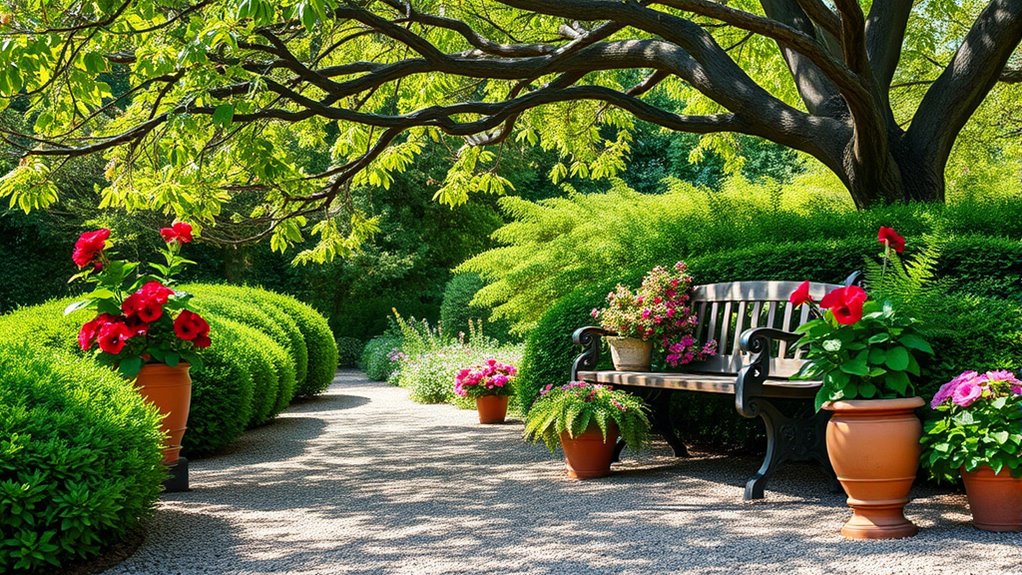To keep your outdoor spaces looking their best, regularly care for your gardens, patios, and paths. Trim and prune plants to prevent overgrowth, clean and sweep surfaces to remove dirt and debris, and fix cracks or uneven spots promptly. Use proper lighting to highlight features and improve safety. With consistent upkeep, your outdoor area will stay inviting and functional. Keep exploring for simple tips that can make your outdoor maintenance easier and more effective.
Key Takeaways
- Regularly inspect and repair garden features, paths, and patios to prevent damage and ensure safety.
- Keep outdoor surfaces clean by sweeping, power washing, and removing debris or weeds.
- Maintain proper lighting by checking bulbs and wiring to enhance safety and aesthetics.
- Prune plants and manage foliage to prevent overgrowth and maintain visual appeal.
- Incorporate focal points and defined zones to create a cohesive, inviting outdoor environment.

A well-maintained outdoor space enhances your home’s beauty and provides a relaxing area for gatherings or quiet moments. To achieve this, paying attention to your garden design is essential. A thoughtfully planned garden creates a cohesive look, balancing colors, textures, and plant heights. Consider incorporating focal points like a water feature, sculpture, or a colorful flower bed to draw the eye and add visual interest. Choose plants that thrive in your climate and match your maintenance preferences, whether you prefer low-maintenance greenery or a lush, flower-filled landscape. Properly planning your garden design also involves creating defined zones—perhaps a cozy seating area, a vegetable patch, or a play space—so your outdoor area is both functional and inviting.
Lighting plays an indispensable role in maintaining your outdoor space, especially when it comes to outdoor lighting. It extends the usability of your yard into the evening hours and enhances safety by illuminating pathways, stairs, and potential hazards. Incorporate different types of outdoor lighting, such as string lights, spotlights, and pathway lamps, to create a layered effect that highlights your garden’s best features while offering practical illumination. Strategically placing lights around trees, shrubs, and architectural elements can add depth and ambiance, transforming your outdoor area into a magical retreat after sunset. Regularly check and maintain your outdoor lighting fixtures—replace bulbs as needed, clean lenses, and ensure wiring is secure—to keep your outdoor space safe and inviting.
Paths are a pivotal element in guiding movement through your outdoor space, and keeping them in good condition helps maintain the overall aesthetic. Whether you’ve chosen gravel, stone, pavers, or concrete, routine maintenance prevents weeds from sprouting between cracks and keeps the surface level. Sweeping or power washing your paths periodically removes dirt, algae, and debris, preserving their appearance and safety. If your paths develop cracks or uneven spots, repairing them promptly will prevent further damage and trip hazards. Additionally, edging your pathways can define their borders sharply, making your garden look more polished. By maintaining your paths along with your garden design and outdoor lighting, you ensure your outdoor space remains both attractive and functional, encouraging you to enjoy it more often.
Frequently Asked Questions
How Often Should I Fertilize My Garden Plants?
For your garden plants, you should establish a fertilizer schedule based on their specific nutrient needs. Typically, fertilize every 4 to 6 weeks during the growing season, but some plants might require more or less frequent feeding. Always observe your plants’ health and adapt accordingly. Regular fertilization ensures they get the nutrients they need to grow strong and healthy, promoting vibrant blooms and lush foliage.
What Are the Best Plants for Shaded Outdoor Areas?
Imagine a quiet, shaded corner where sunlight gently filters through leaves, creating a cool haven. You’ll love shade-loving perennials like hostas, ferns, and astilbes that thrive in low-light foliage, adding lush greenery and delicate flowers. These plants brighten shaded outdoor areas effortlessly, requiring minimal maintenance. With their vibrant textures and soothing colors, you turn shadowy spots into inviting retreats, making your outdoor space beautifully alive even in the dimmest corners.
How Can I Prevent Weeds From Overtaking My Pathways?
To prevent weeds from overtaking your pathways, focus on effective weed control and regular pathway maintenance. You can lay down a weed barrier fabric underneath your pathway materials, and remove weeds as soon as they appear to stop them from spreading. Regularly sweep and check for cracks or gaps where weeds might grow, and consider using a weed-preventive sealant or herbicide for long-term protection. Consistent upkeep keeps your pathways clean and weed-free.
What Materials Are Most Durable for Outdoor Patios?
To guarantee your outdoor patio lasts, choose durable materials like concrete or pavers. Paver installation offers flexibility and resistance to cracking, while concrete sealing protects against weather damage and stains. You should consider sealing your concrete regularly to extend its lifespan. These materials withstand heavy use and harsh weather, making your patio a long-lasting, attractive addition to your outdoor space.
How Do I Winterize My Outdoor Space Effectively?
To winterize your outdoor space effectively, start by cleaning and removing debris, then protect plants with mulch or coverings. Don’t forget to perform seasonal pruning to prevent damage and promote healthy growth. Store or disconnect outdoor lighting to prevent freezing issues. Cover furniture and delicate features, and make certain pathways are clear and salted if needed. These steps help your space withstand winter’s challenges and stay inviting for spring.
Conclusion
By keeping your outdoor spaces in tip-top shape, you’ll turn your yard into the envy of the neighborhood—like a secret garden straight out of a fairy tale! With just a little effort, your gardens, patios, and paths will shine brighter than the sun itself, making every moment outside feel like a royal retreat. So grab your tools, get to work, and watch your outdoor paradise become the stuff of legends—an epic masterpiece you’ll never want to leave!








